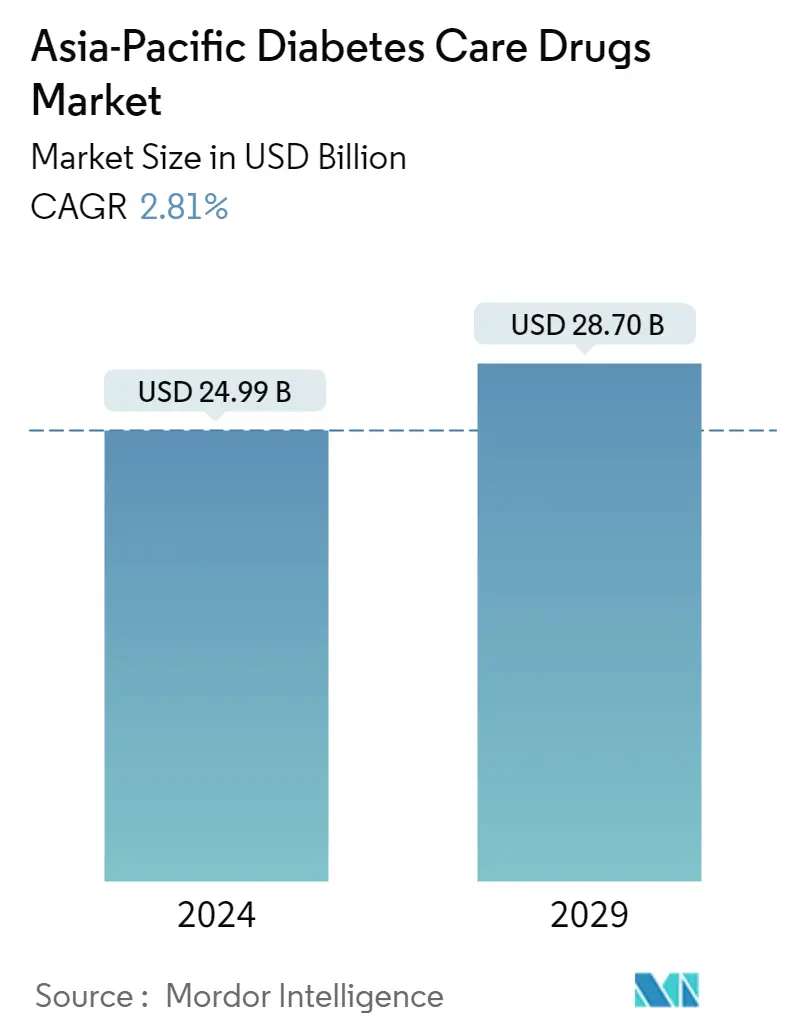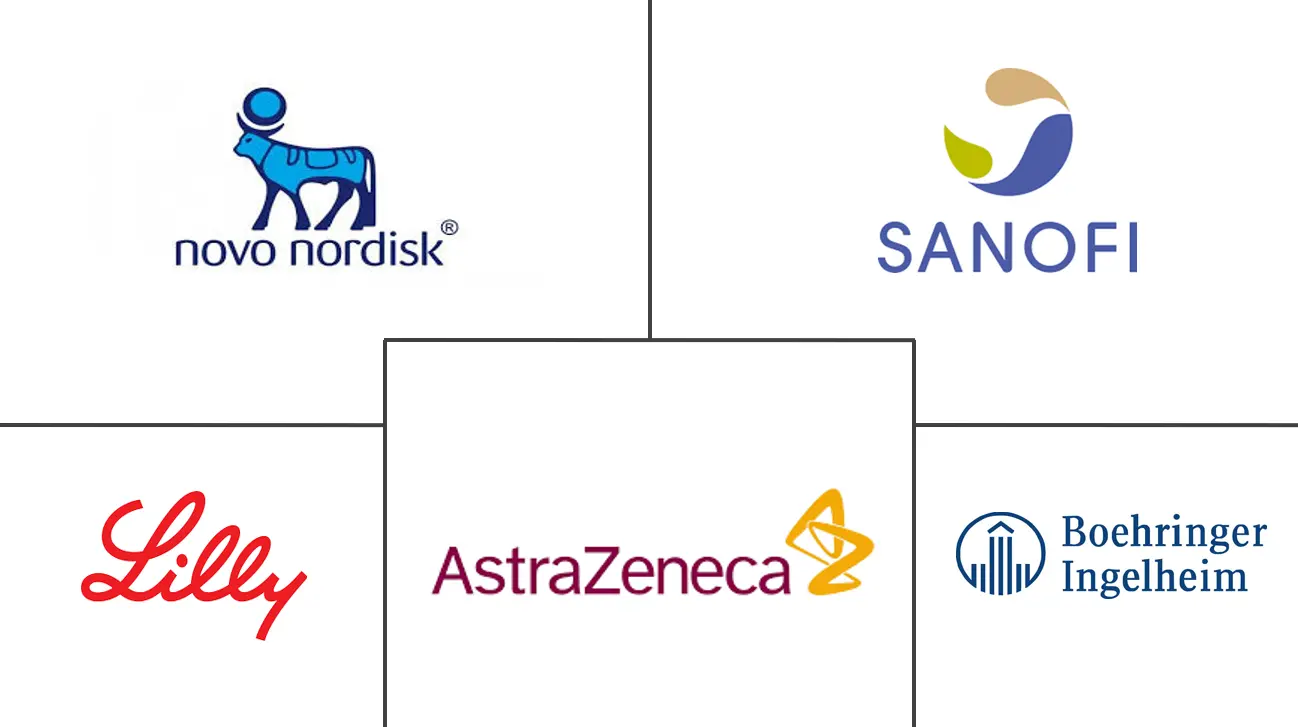Market Size of Asia-Pacific Diabetes Care Drugs Industry

| Study Period | 2018 - 2029 |
| Base Year For Estimation | 2023 |
| Market Size (2024) | USD 24.99 Billion |
| Market Size (2029) | USD 28.70 Billion |
| CAGR (2024 - 2029) | 2.81 % |
| Market Concentration | Low |
Major Players
*Disclaimer: Major Players sorted in no particular order |
Asia-Pacific Diabetes Care Drugs Market Analysis
The Asia-Pacific Diabetes Care Drugs Market size is estimated at USD 24.99 billion in 2024, and is expected to reach USD 28.70 billion by 2029, growing at a CAGR of 2.81% during the forecast period (2024-2029).
Over the past few decades, Asian countries have witnessed a rapid increase in diabetes patients, especially those with type 2 diabetes. Developing countries have more than 70% of the global diabetes population. The Asia -Pacific is anticipated to experience considerable growth due to a more geriatric population and rising prevalence of diabetes mainly due to the enhanced stress level, sedentary lifestyles, smoking, and excessive consumption of alcohol that elevates the body's sugar levels have led to the growth of the market.
Moreover, the production basis of certain antidiabetic drug companies in the region also boosted the market growth. However, the increasingly high cost of drugs is considered one of the major restraining factors for the market. According to the OECD iLibrary in Asia-Pacific, about 227 million people live with type 2 diabetes and about half of them are undiagnosed and unaware of developing long-term complications.
Therefore, owing to the aforementioned factors the studied market is anticipated to witness growth over the analysis period.
Asia-Pacific Diabetes Care Drugs Industry Segmentation
Diabetes drugs are used to manage diabetes mellitus by lowering the glucose level in the blood. The Asia-Pacific diabetes care drugs market is segmented into drugs, by Route of Administration and geography. The report offers the value (in USD) and volume (in ml) for the above segments.
| Oral Anti-diabetic Drugs | |||||||
| |||||||
| |||||||
| |||||||
| |||||||
| |||||||
| |||||||
|
| Insulins | |||||||
| |||||||
| |||||||
| |||||||
|
| Combination drugs | |||||
| |||||
|
| Non-Insulin Injectable drugs | |||||||
| |||||||
|
| By Route of Administration | |
| Oral | |
| Subcutaneous | |
| Intravenous |
| Geography | |
| Australia | |
| China | |
| India | |
| Indonesia | |
| Japan | |
| Malaysia | |
| Philippines | |
| South Korea | |
| Thailand | |
| Vietnam | |
| Rest of Asia-Pacific |
Asia-Pacific Diabetes Care Drugs Market Size Summary
The Asia-Pacific diabetes care drugs market is poised for significant growth, driven by an increasing prevalence of diabetes, particularly type 2, across the region. This surge is attributed to factors such as an aging population, sedentary lifestyles, and lifestyle choices like smoking and excessive alcohol consumption, which elevate sugar levels. The market benefits from the presence of major antidiabetic drug manufacturers in the region, although high drug costs pose a challenge. Oral anti-diabetic drugs dominate the market due to their efficacy, safety, and cost-effectiveness, making them a preferred choice for managing type 2 diabetes. The introduction of new-generation oral drugs, such as DPP-4 and SGLT-2 inhibitors, has further enhanced their appeal by reducing cardiovascular risks and improving patient adherence to treatment.
China stands out as a key player in the Asia-Pacific diabetes drug market, with a substantial share and a growing number of generic drug manufacturers. The country faces challenges like slow economic growth and an aging population but continues to see a rising preference for oral anti-diabetics among patients. Initiatives like the National Essential Medicine System and reimbursement policies aim to alleviate the financial burden on diabetic patients, supporting market expansion. The market is characterized by fragmentation, with both global and regional players competing for market share. Recent mergers and acquisitions have strengthened the presence of key manufacturers, fostering innovation and market growth.
Asia-Pacific Diabetes Care Drugs Market Size - Table of Contents
-
1. MARKET DYNAMICS
-
1.1 Market Overview
-
1.2 Market Drivers
-
1.3 Market Restraints
-
1.4 Porter's Five Forces Analysis
-
1.4.1 Bargaining Power of Suppliers
-
1.4.2 Bargaining Power of Consumers
-
1.4.3 Threat of New Entrants
-
1.4.4 Threat of Substitute Products and Services
-
1.4.5 Intensity of Competitive Rivalry
-
-
-
2. MARKET SEGMENTATION
-
2.1 Oral Anti-diabetic Drugs
-
2.1.1 Biguanides
-
2.1.1.1 Metformin
-
-
2.1.2 Alpha - Glucosidase Inhibitors
-
2.1.2.1 Alpha - Glucosidase Inhibitors
-
-
2.1.3 Dopamine -D2 Receptor Agonist
-
2.1.3.1 Bromocriptin (Cycloset)
-
-
2.1.4 Sodium-glucose Cotransport -2 (SGLT-2) Inhibitor
-
2.1.4.1 Invokana (Canagliflozin)
-
2.1.4.2 Jardiance (Empagliflozin)
-
2.1.4.3 Farxiga/Forxiga (Dapagliflozin)
-
2.1.4.4 Suglat (Ipragliflozin)
-
-
2.1.5 Dipeptidyl Peptidase - 4 (DPP-4) Inhibitors
-
2.1.5.1 Januvia (Sitagliptin)
-
2.1.5.2 Onglyza (Saxagliptin)
-
2.1.5.3 Tradjenta (Linagliptin)
-
2.1.5.4 Vipidia/Nesina (Alogliptin)
-
2.1.5.5 Galvus (Vildagliptin)
-
-
2.1.6 Sulfonylureas
-
2.1.6.1 Sulfonylureas
-
-
2.1.7 Meglitinides
-
2.1.7.1 Meglitinides
-
-
-
2.2 Insulins
-
2.2.1 Basal or Long Acting Insulins
-
2.2.1.1 Lantus (Insulin Glargine)
-
2.2.1.2 Levemir (Insulin Detemir)
-
2.2.1.3 Toujeo (Insulin Glargine)
-
2.2.1.4 Tresiba (Insulin Degludec)
-
2.2.1.5 Basaglar (Insulin Glargine)
-
-
2.2.2 Bolus or Fast Acting Insulins
-
2.2.2.1 NovoRapid/Novolog (Insulin Aspart)
-
2.2.2.2 Humalog (Insulin Lispro)
-
2.2.2.3 Apidra (Insulin Glulisine)
-
-
2.2.3 Traditional Human Insulins
-
2.2.3.1 Novolin/Actrapid/Insulatard
-
2.2.3.2 Humulin
-
2.2.3.3 Insuman
-
-
2.2.4 Biosimilar Insulins
-
2.2.4.1 Insulin Glargine Biosimilars
-
2.2.4.2 Human Insulin Biosimilars
-
-
-
2.3 Combination drugs
-
2.3.1 Insulin combinations
-
2.3.1.1 NovoMix (Biphasic Insulin Aspart)
-
2.3.1.2 Ryzodeg (Insulin Degludec and Insulin Aspart)
-
2.3.1.3 Xultophy (Insulin Degludec and Liraglutide)
-
-
2.3.2 Oral Combinations
-
2.3.2.1 Janumet (Sitagliptin and Metformin)
-
-
-
2.4 Non-Insulin Injectable drugs
-
2.4.1 GLP-1 receptor agonists
-
2.4.1.1 Victoza (Liraglutide)
-
2.4.1.2 Byetta (Exenatide)
-
2.4.1.3 Bydureon (Exenatide)
-
2.4.1.4 Trulicity (Dulaglutide)
-
2.4.1.5 Lyxumia (Lixisenatide)
-
-
2.4.2 Amylin Analogue
-
2.4.2.1 Symlin (Pramlintide)
-
-
-
2.5 By Route of Administration
-
2.5.1 Oral
-
2.5.2 Subcutaneous
-
2.5.3 Intravenous
-
-
2.6 Geography
-
2.6.1 Australia
-
2.6.2 China
-
2.6.3 India
-
2.6.4 Indonesia
-
2.6.5 Japan
-
2.6.6 Malaysia
-
2.6.7 Philippines
-
2.6.8 South Korea
-
2.6.9 Thailand
-
2.6.10 Vietnam
-
2.6.11 Rest of Asia-Pacific
-
-
Asia-Pacific Diabetes Care Drugs Market Size FAQs
How big is the Asia-Pacific Diabetes Care Drugs Market?
The Asia-Pacific Diabetes Care Drugs Market size is expected to reach USD 24.99 billion in 2024 and grow at a CAGR of 2.81% to reach USD 28.70 billion by 2029.
What is the current Asia-Pacific Diabetes Care Drugs Market size?
In 2024, the Asia-Pacific Diabetes Care Drugs Market size is expected to reach USD 24.99 billion.

